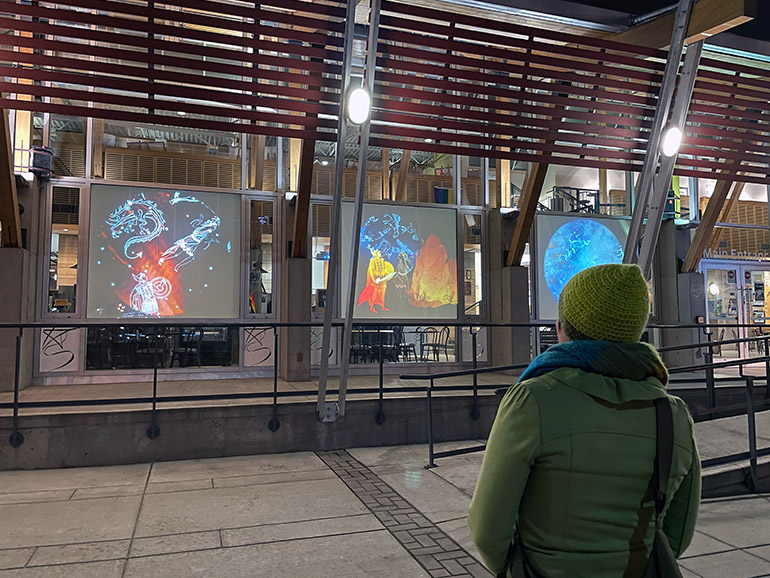
Celestial Bodies: Four Stories of the Night Sky, projections will be shown at the Rotary Centre for the Arts until February 28.
Public art adds beauty to the community and lets us reflect on what is in front of us
Public art can take many forms, from mural paintings to installations and exhibitions, to large scale sculptures. It can work to revitalize the urban landscape while supporting and improving the cultural, social and economic vitality of our local community.
UBC Okanagan’s Faculty of Creative and Critical Studies (FCCS) is deeply committed to community engagement, says Denise Kenney. Artists do not just make art for themselves, she says, but rather enter into conversation with their communities—public art and community engagement is the most honest and direct example of that.
Kenney is an educator, filmmaker, eco-artist and performer. She teaches interdisciplinary performance and film at UBCO and is currently the department head for Creative Studies.
Why is public art important?
I believe it is vital. I always ask my students, “If art and artists are really ‘fluff,’ then why do so many oppressive regimes target artists?” The way we converse with our communities is through our art. Art matters.
Every day we engage with art and aesthetics in some way. Everything from the way our cell phones are designed, to our toasters, furniture, films, books and what we have on the walls in our houses. It is all around us. But art is much more than just design—it builds resiliency in our communities and helps us to understand other points of view and perspectives.
How do FCCS students and faculty contribute to the vibrancy of our arts community?
We host a number of events where people share poetry, writing, performance work, installations and exhibitions. These events are essentially social practice projects where we engage in conversations with and for our community. Our art is sometimes a catalyst or a container for dialogue or community conversation, sometimes an offering of beauty and sometimes a provocateur or interrupter.
The university is able to leverage our resources, which are fresh young people who can teach us what this next wave is, what people are thinking, how these younger people see the world, and what their issues are. Having our students work in the community keeps us all on the pulse of emerging ideas and concerns. It keeps us vibrant.
What previous projects have UBCO students, faculty and alumni added to the public art in the community?
We see some of our faculty and alumni work on banners along Main Street in Lake Country as part of a public art commission done by that municipality. And the tree grates and light stands in downtown Kelowna, and the bronze sculpture of Chief Charlie swkn̓cut outside of the tourism centre are all done by Bachelor of Fine Arts (BFA) and Master of Fine Arts alumna Crystal Przybille.
Just last summer, through a painting course with BFA alumnus and current painting instructor David Doody, our BFA students created a large-scale mural on the back of a downtown Kelowna building. Students from the BFA program also worked on a mural design to transform University Way into an experimental public art piece.
The Living Things Festival presented The Collective Body which was a series of projections outside of the Rotary Centre for the Arts (RCA) that included work from our students and faculty. Currently, projections in this space showcase fascinating stories of the night sky in a new exhibit called Celestial Bodies.
During the pandemic, how is FCCS working to exhibit students’ work?
We are all struggling under the weight of the pandemic. And rather than students feeling like they are the victims of the pandemic, it is a great opportunity for us to say this is the time when artists have something to offer back. We have found a safe way for our students to experience their relevance and importance in the community and at the same time offer something that gives the community a moment of distraction, contemplation and aesthetic arrest in the context of the pandemic.
Along with our upcoming Spring Festival, our students and faculty are working on several online events including our BFA graduation show, the announcement of our Okanagan Short Story contest winners and the launch of this year’s Papershell anthology, showcasing student work from our creative writing program.
We specifically want to get away from so much online engagement, so in addition to those events we will be exhibiting student work in our FINA Gallery, through the Rotary Centre for the Arts, the Lake Country Art Gallery Town Wall and outdoor Mural space and in the Alternator Gallery. We will also be showcasing student work on postcards, street banners and digital projections.
About UBC’s Okanagan campus
UBC’s Okanagan campus is an innovative hub for research and learning founded in 2005 in partnership with local Indigenous peoples, the Syilx Okanagan Nation, in whose territory the campus resides. As part of UBC—ranked among the world’s top 20 public universities—the Okanagan campus combines a globally recognized UBC education with a tight-knit and entrepreneurial community that welcomes students and faculty from around the world in British Columbia’s stunning Okanagan Valley.
To find out more, visit: ok.ubc.ca